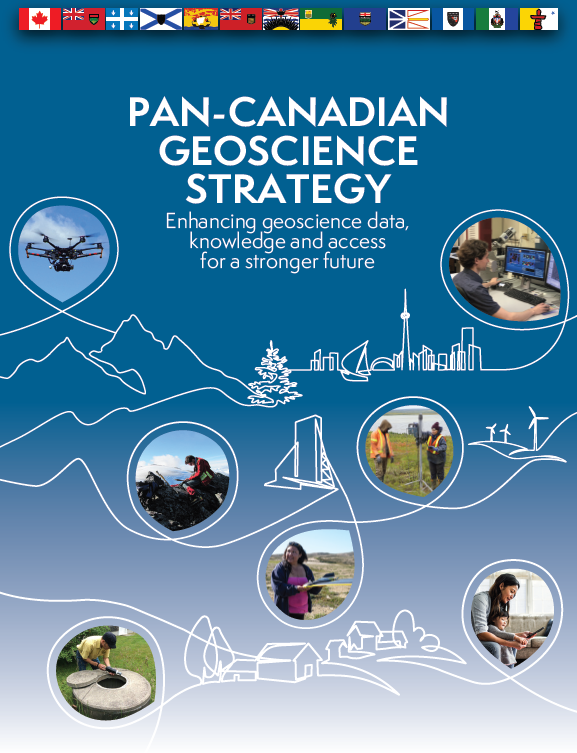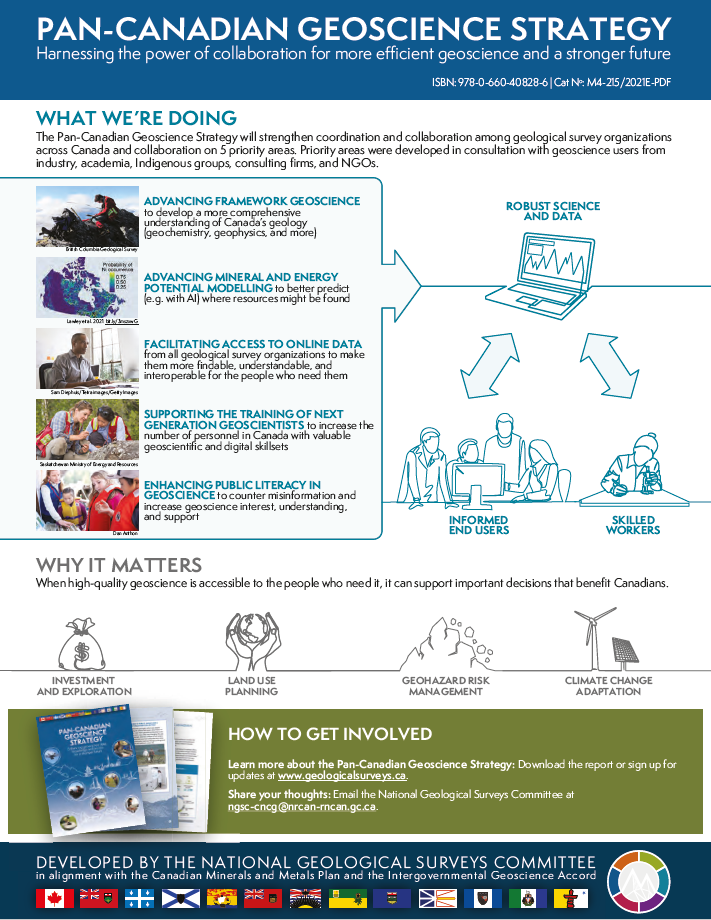Pan-Canadian Geoscience Strategy

The Pan-Canadian Geoscience Strategy (PGS) represents a renewed commitment to federal, provincial and territorial collaboration for delivering accessible geoscience data and knowledge for all Canadians.
It responds to:
- calls from governments and stakeholders to explore options for improving public geoscience coordination and funding
- federal, provincial and territorial Minister commitments under agreements such as the 2017 Intergovernmental Geoscience Accord (9 pages, 2 MB), the Canadian Minerals and Metals Plan and the related Action Plan 2020
Members of the National Geological Surveys Committee (NGSC) have agreed to coordinate their efforts on the following priority areas:
- Advancing framework geoscience
- Advancing mineral and energy potential modelling
- Facilitating access to online data
- Supporting the training of next generation geoscientists
- Enhancing public literacy in geoscience
These priority areas were developed and verified in consultation with a cross-section of stakeholders and Indigenous organizations.
Benefits of the Strategy

The PGS supports a long-term vision to provide geoscience information that underpins the responsible development of Canada’s geological resources (geo-resources) and serves the public good. For example, geoscience can help to:
- inform mineral and energy investment and exploration decisions (benefit: competitive natural resources sector)
- inform sustainable development and land use decisions (benefit: evidence-based conservation)
- understand environmental and public safety risks associated with resource development and geological hazards (benefit: safe infrastructure development)
By providing a diverse, extensive and sound base of evidence, geoscience also enables decision-makers to quickly respond to society’s evolving expectations for responsible land and resource management.
In developing the PGS, the NGSC recognizes that collaboration and coordination can foster greater efficiency and innovation in geoscience. The NGSC also acknowledges that the benefits of geoscience rely on a synergy of robust geoscience and data, skilled workers, and informed end users.
Where we are and where we’re going
The PGS builds on extensive existing geoscience work and collaborations. This work will continue, with enhanced coordination between geological survey organizations over the coming months and years.
Between the end of June 2023 and the end of May 2024, the NGSC has advanced the priority areas described in the PGS as follows:
1. Advancing framework geoscience
- The NGSC built on the success of 2023 federal-provincial-territorial workshops by starting a new cycle of regional framework geoscience workshops. These workshops aim to develop broad outlines of geoscience projects that could fill knowledge gaps in different geological regions and enhance Canada’s attractiveness for investment.
2. Advancing mineral and energy potential modelling
- A working group will conduct a survey among NGSC members to evaluate the state of mineral and energy potential modelling. A set of “best practices” in Canadian contexts will be determined and made available to NGSC members. A similar scan of international practices will be conducted at a later time.
3. Facilitating access to online data
- A working group piloted an online data network that for the first time integrates data on mineral occurrences, by linking existing federal, provincial, and territorial information systems. They are now working to broaden the extent of the project to include more provinces and territories, and to make the data more queryable.
4. Supporting the training of next generation geoscientists
- A working group held a workshop to further discuss the results of last year’s survey about hiring and training best practices, with special focus on how to foster equity, diversity, and inclusion.
- One goal for the future is to develop an online tool to connect next generation geoscientists with potential work or training opportunities in GSOs across Canada.
5. Enhancing public literacy in geoscience
- NGSC members held geoscience events at a few locations across Canada for public engagement on International Geodiversity Day. Established by UNESCO during the 41st General Conference in 2021, International Geodiversity Day marks a worldwide celebration to promote the many aspects of geodiversity.
The progress report for this year (which provides further detail in addition to the highlights above) will be available online later this summer. In the meantime, you can find our previous progress reports on our Publications and Resources page.
To keep up with PGS news, keep checking this website or sign up to receive updates!
